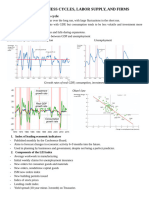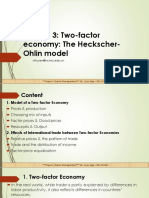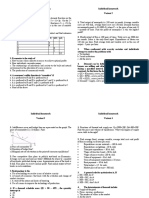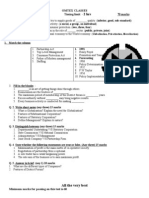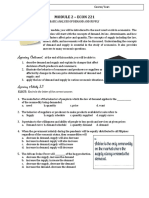HO Model Notes
Uploaded by
ecsHO Model Notes
Uploaded by
ecsHeckscher-Ohlin Model Production Possibilities Frontier with Factor
Substitution
New Concepts in the HO Model
- Factor Proportions Theory
- Comparative Advantage
o Relative abundance of resources
o Relative factor intensities
o Factor substitution – in the HO Model, it
is possible that we do not want factor
substitution to happen
Income distribution effects were not included in the
Ricardian model. It is included in the HO model.
Setting up the HO Model
1) 4 Frameworks
a. Prices and Production
b. Choices of Inputs – Factor Intensity Assumptions of the H-O Model
c. Factor Price and Goods Prices - The labor-capital ratio is a function of relative
d. Factor Allocation (Resources) and factor prices, L/K = f(w/r)
Output o L – Labor, K – Capital, w – wage, r –
i. These four variables allow us to interest
link trade with income - Factor intensity
distribution effects - The production of food is capital-intensive
ii. H-O stills assumes perfect - The production of cloth is labor-intensive
competition and comparative - Production of a good cannot be labor and land
advantage. intensive. If it is, we cannot isolate the effect of
iii. Sources of comparative factor intensity .
advantage are the relative o In real life, how come high-technology
abundance of resources and can be skill-intensive and technology-
factors are combined to intensive?
produce goods (unlike in ▪ Land – rent, Labor – wage,
Ricardian factor productivity Capital – interest, Entrep –
was the basis) profit
2) Assumptions: HO Model ▪ What is capital? It is a good that
a. There are 2 countries: H and F is not consumed.
b. There are 2 goods: Cloth (C) and Food ▪ To distinguish skilled vs
(F) unskilled workers, we have
c. There are 2 factors: K and L with ways of segregating workers
substitutions with exams such as CFA exam.
d. The amount of capital to produce one ▪ If a worker becomes skilled, it is
unit of cloth (akc), the amount of labor no longer earning wage.
to produce one unit of cloth (alc), the ▪ It is now another factor of
amount of capital to produce one unit production.
of food (akf), and the amount of labor • There is physical
to produce one unit of food (alf): capital, human capital
amount of factor needed to produce a (skilled labor), and
unit of output technology.
e. Both countries use the same technology • Technology is part of
f. Trade is costless capital.
g. Both countries produce both goods
It is an upward sloping graph. As factor prices increase,
Given our arbitrary assumptions that food is capital-
goods prices will increase.
intensive while cloth is labor-intensive.
It is downward sloping because if the factor prices go
The Heckscher Ohlin Model So Far
up, the amount of labor used as a proportion of capital
- Factor Intensity
will decrease for food. It is the same for cloth too. If
- Given factor prices (w/r), the ratio of labor to
factor price goes up, the production of cloth will use
capital (L/K) is determined
less labor as a ratio of capital. But there is a huge
- Given perfect competition, we can link the
different. At (w/r)1, there is only one factor price. At the
prices of goods (Pc/Pf), the factor prices ratio
same factor price ratio, the labor to capital ratio in food
(w/r), and the labor to capital ratio (L/K).
production is less than the labor to capital ratio of cloth.
- This linked model will help us analyze income
The production of cloth uses more labor relative to
distribution effects.
capital than the production of food. Therefore, cloth is
labor-intensive.
What happens to the price of cloth when wages go up
relative to the price of a good that is not labor-
Factor prices and Goods prices
intensive? Increase in wage will have a stronger effect
The Samuelson-Stolpher Effect
on the price of cloth because it is labor-intensive. The
- Cost of production depends on factor prices
price of food will be affected too.
- Price of a good= cost of production ( there are
no profits)
Ma’am’s Analyst Story: Firms request the tariff for
o Px= w*L + i*K+ r*T+ p*E
phosphorous be lessened. Checked the unit cost of
- Wage- Labor (2nd); interest rate – capital
phosphorous. Matches are 50% stick. Phosphorous was
(industrial revolution; bourgeoise); rent to land
a small component of a matchstick. Removing the tariff
(always there; oldest); and profits to
was insignificant.
entrepreneur (1950s) .
- Factor intensity : stronger relationship between
The effect on the good prices of a factor price increase
cost, factor prices and goods prices
will be stronger if the factor that is intensive is the
Because of factor intensity, there is now a
factor whose price increased.
stronger relationship between cost, factor
prices and good prices
The candidate factor of production is technology
▪ When diminishing returns set
in, the marginal product of
labor decreases as you add
more labor to capital. When
you turn it around, you use less
labor and more capital, the
marginal product of labor
increases. The marginal product
of capital in both production
decreases.
- Marginal product of capital in cloth and food
DECREASES
- In resource pricing, you hire laborers until the
value of their marginal product of labor is equal
to their wage.
Factor prices and factor intensity - Laborer’s income increases → Workers
What is the implication from this? purchasing power increases
Relative factor prices (w/r) are the common link by - This increase in income comes from the
which you can argue the relationship of goods prices to increase in goods prices.
factor intensities. Additional: If the marginal product of labor involves
cloth and food production increase, workers’ purchasing
If the increase in factor prices means that good prices power increases. Both workers in the cloth and food
will increase stronger, in the absence of any increase in industry win. The capital for cloth and food are lose. In
factor prices if goods prices increase [(Pc/Pf)1 -> real terms, the incomes of workers increases whether
(Pc/Pf)2], what does that bring you to conclude? You you are working in the cloth or food industry. Capitalists
can also conclude that relative factor price will increase. lose.
Resources and Output
The relative factor price is associated with a labor- • Given those changes, how will resources and
capital ratio in food and cloth. output change. How will the output mix
change?
Relative Goods Prices and Income Distribution • If there is an increase in the supply of labor,
- Increase in goods prices (Pc/Pf) leads to a even if the relative price of cloth remains
decrease in labor to capital ratio in both cloth constant, the output of cloth will increase while
and food production at the same time the output of food will
- Labor has become more expensive than capital. decrease.
o Therefore there will be more capital, • There is a bias expansion because the output of
less labor, in production of food and cloth will increase because it is labor-intensive
cloth. and the factor that increased is labor.
o It will affect cloth more because it is • An economy will be more efficient in producing
labor-intensive while food is capital- a good that is intensive in the abundant factor.
intensive
- Marginal product of labor in cloth and food
INCREASES because you use less of it
o What is your production theory when
you combine two factors to produce
one good?
▪ We use a variable factor
combined with a fixed factor.
Diminished returns sets in.
- Home will produce a higher ratio of cloth to
food
- The relative supply curve of Home is lower/to
the right of Foreign
Their slopes are parallel meaning their slopes are equal
and that prices have not changed.
If you produce more cloth, you will use more labor
supply, this additional labor will come from the increase
in the labor supply and from laborers moving from the
production of food to cloth.
Income Distribution
The first conclusion is that the economy will be more
efficient at producing goods intensive in the abundant Relative demand is a decreasing function of relative
factor. This determines the comparative advantage. If prices, so as relative goods prices go down, the relative
they are more efficient in producing the good intensive quantity of cloth demanded increases.
in abundant factor, the price of that abundant factor Relative supply is upward sloping. As relative prices of
will be relatively lower. The price of that good that is goods go up, both countries are willing to supply more
intensive in the abundant factor will be cheaper. The cloth relative to food. It is upward sloping because both
price of that good intensive in the scarce factor will be countries produce both goods pre-trade. The allocation
more expensive. of labor is indeterminate. It only becomes determinate
after trade.
We used an increase in the supply of labor because we The first observation, at point 1, the relative goods
want to demonstrate that the economy is abundant prices is the intersection of the RS curve in Home and
labor, and that the abundance of labor is tied to the the relative world demand. At point 3, the RS curve in
assumption of Heckscher-Ohlin that is the relative Foreign intersects with the relative world demand.
abundance of factors. These are the relative prices before the countries trade.
Trade in Heckscher-Ohlin Model Pre-Trade in HO Model
Assumptions - Relative prices in Home are less than the
- Relative demand is the same for Home and relatives prices of Foreign
Foreign given the same relative prices (Pc/Pf) - These drives trade.
- Technology is the same - These differences in relative prices drive
- Home is labor-abundant for a given relative straight on the basis of comparative advantage,
factor price (w/i), the labor-capital ratio in but the source of comparative advantage is
Home is greater than in Foreign. different. It is because of differences in factor
- Foreign is capital-abundant endowment and factor intensities.
- Production of cloth is labor-intensive - Home will export cloth because its relative price
- Production of food is capital-intensive of cloth is cheaper; Foreign will export food.
- Each country will export goods whose o The labor to capital ratio will increase
production is intensive in the abundant factor for Foreign.
o Home will export cloth because Home is o Their marginal product of labor drops.
labor-abundant and cloth is labor- o The marginal product of capital
intensive. increases
- The country will import goods that is intensive o Capitalists will be better off; laborers
in the scarce factor. will be worse off.
o Home will import food because food is - If countries did not trade, the abundant factor
capital-intensive, and Home is labor- in the respective countries would earn less
abundant. - We assume homogeneous goods and factors
- The convergence of goods prices will lead to a
Post-Trade in HO Model convergence of factor prices
- As a result of trade, the equilibrium relative
price is at point 2. Stolpher-Samuelson
- Home will export cloth; it will drive the price of Because of the factor intensity and factor endowments,
the cloth up because Foreign will demand more the effect of changes in relative goods prices on income
cloth. distribution effect is intensified because of that factor
- It will drive the price of food down because if intensity. It is so strong that the returns to that
relative prices must increase, the price of food abundant factor, it is at the expense of the scarce
must decrease. factor.
- Equilibrium world relative price is at point 2,
Pc/Pf. It is in between the pre-trade relative The income distribution results does not depend on
prices. whether labor or capital were mobile or not.
- The foreign relative price of cloth (Pc/Pf) will
decrease because the price of food (Pf)will Synonym for mobility is specific. When a factor is
increase for Foreign. It will increase because specific to a sector, it cannot move. For example,
Foreign will export food because it is a capital- capital, the equipment for the cheese sector is specific
abundant country, and the production of food is only to the cheese industry.
capital-intensive. Over time, the capital equipment will depreciate.
- If there is no trade, the relatives goods prices in Capital goods will move to another industry from the
their respective countries would be lower. cheese sector to another.
- The implication of these convergence of relative
goods prices is the income distribution effects. - Implication: Trade is a substitute for
international factor mobility
Income Distribution Effects in HO - Factors did not move. The country with the
- In Home, when the relative goods prices abundant factor produced the good which was
increase after trade, relative factor prices will cheaper.
increase.
- When the relative factor prices (w/r) increase, Case Study on Income Distribution
labor is more expensive. The labor to capital The income distribution effect based on factor
ratio of both food and cloth in Home decreases. endowments and relative factor intensities. Wage
- Laborers will be better off, and capitalists will inequality is currently observed in the most developed
be worse off. If producers of food and cloth will countries like the US. Wage inequality is also observed
both reduce the employment of labor. The in other developing countries. It is also observed to a
marginal product falls lesser extent in China and Brazil.
- In Foreign, the relative goods prices (Pc/Pf) will
fall.
o Factor prices (w/r) will decrease. Capital
is more expensive.
The US is capital-rich and labor-scarce. Krugman cited three arguments that gives rise to
- Price convergence: goods → factor prices skepticism to the contention that trade leads to rising
- Increasing wage inequality in countries wage inequality.
implementing trade liberalization 1st: There is no empirical proof that there is an increase
- Growing exports of manufactured goods, rather in the relative goods prices of skill-intensive products
than raw materials and agricultural goods from versus prices of unskilled-labor-intensive goods in the
NIEs US. Changes in relative goods prices of skill-intensive
o Increasingly displacing labor-intensive products vs prices of unskilled (low-wage) goods.
output in the US
o Exports of NIEs are low-tech products 2nd: Convergence of relative factor prices; in developing
intensive in unskilled labor and scarce in countries that have liberalized trade, wage inequality
skilled labor has increased too.
o Export structure of Hong Kong and - On SS graph, wage inequality between skilled
Taiwan are different (they moved away and unskilled workers will increase only if the
from the exports of resourced based relative prices of goods increase. There must be
agri products to manufactured goods) an increase in the prices of products intensive in
- Issue: Is trade the main factor contributing to skills relative to prices of products intensive in
increasing wage inequality? unskilled labor. The inequality must come from
somewhere.
All countries have relatively opened their trade. - China and Brazile have inequality wages
What is the main problem if there is a growing wage between skilled and unskilled labors
inequality in developing countries whose economies are
opened to trade? It is difficult to defend free trade. 3rd: The share of skilled labor in skill-intensive exports of
developed countries and share of unskilled labor in
According to HO, if Pc/Pf increases, there will be an labor-intensive imports are a small fraction of total
increase in the w/r, L/K will fall. This leads to the supply of skilled and unskilled labor.
abundant factor becoming better off.
The main culprit is not trade.
Wage inequality is coming from the factor of production
labor. What drives inequality between income of skilled and
unskilled workers?
In the US, wages in sunset industries are relatively lower - New production technology – innovation – that
compared to industries like Silicon Valley. uses skilled labor
o When you have a new technology, that
It is skilled vs unskilled labor. In the US, their wage in for innovation almost always requires that
skilled workers is higher than their unskilled workers. it be used together with higher skilled
They attribute this to trade. This trend, however, is also labor. New technology is not a
observed in China and Brazil, which are unskilled labor- substitute for unskilled labor. In
abundant and skilled labor-scarce. operating a machine, there is a
complementary demand for high skilled
Contention that trade drives this wage inequality is not labor.
tenable. - Skill-biased technological change: Skilled labor is
not a substitute for capital but is a complement
Wage inequality can be demonstrated by looking at the o Demand for skilled labor will go up
wage ratio between skilled and unskilled labor. - Trade openness/liberal trade regimes foster
adoption of technology upgrades
- Two goods : high-tech (H); low-tech (L) o The employment of skilled-unskilled
- Two factors: skilled and unskilled labor ratio increase.
- Factor intensities: production of H is skilled o You need more workers capable of
labor intensive; production of L is unskilled using newer technology. There’s a
labor intensive greater demand for skilled workers so
- HH curve is to the right of the LL curve the relative wages (ws/wu) will rise.
- Given relative wage (ws/wu), production of H o The demand for more skilled workers in
uses more skilled labor such that Sh/Uh > SL/UL both the production of low-tech goods
- Factor intensities are shown in panel (a) in the and high-tech goods will increase.
graph - For any given Ph/Pl, good price is associated
with a higher ws/wu.
---
- More recent research – trade contributed
indirectly to the increase in income inequality
by accelerating the technological change.
o Trade is conducive to technological
change
- Trade openness gives firms an opportunity of
production choices
H-O Theory and Empirical Evidence
- The Leontief Paradox
- Leontief (1953) found that US exports were less
capital-intensive than US imports.
- Russian economist, Nobel prize in 1971. Input
Case Study of Income Distribution output table.
- Case A: Increased trade generates wage - Leontief’s article debunked the Heckscher-Ohlin
inequality Model.
- Given an increase in relative price of high tech - Leontief found that US imports were more
goods (Ph/Pl), the relative wages in the skilled capital-intensive than US exports.
sector to the wages in the unskilled sector - There was still no decomposition of Capital as
(ws/wu) will increase; producers in both into three types of Capita: Human, Hard, and
sectors, will decrease the employment of skilled Technology
workers because it has become more - How do you measure technology? It is
expensive. Employment falls and the marginal embodied in capital. A better equipment.
product goes up. - Skill is capital.
- Case B: The technological change in both - The problem is decomposing labor into skilled
sectors generates wage inequality and unskilled.
- Technology change is skill-biased - The skilled component of labor and only the
o We initially assumed the technology is unskilled portion, the imports of US would not
the same. be less (more?) capital intensive than US,
o This leads to the shift of the HH and LL because it would only capture unskilled labor.
curve.
- Both HH and LL shifts the relative demand for
skilled workers
o Skilled-unskilled employment ratio
increases but the skilled-unskilled wage
ratio is the same.
You might also like
- Unit 2 Review: 1. The Demand Curve For A Normal Good Slopes Down For Which of The Following Reasons?No ratings yetUnit 2 Review: 1. The Demand Curve For A Normal Good Slopes Down For Which of The Following Reasons?11 pages
- Prepared by Iordanis Petsas To Accompany by Paul R. Krugman and Maurice ObstfeldNo ratings yetPrepared by Iordanis Petsas To Accompany by Paul R. Krugman and Maurice Obstfeld44 pages
- Resources and Trade: The Heckscher-Ohlin Model: © Pearson Education Limited 2015No ratings yetResources and Trade: The Heckscher-Ohlin Model: © Pearson Education Limited 2015104 pages
- RIngkasan Teori Perdagangan InternasionalNo ratings yetRIngkasan Teori Perdagangan Internasional5 pages
- Resources and Trade: The Heckscher-Ohlin Model: Eleventh EditionNo ratings yetResources and Trade: The Heckscher-Ohlin Model: Eleventh Edition24 pages
- IGSCE economics - the basic economic problemNo ratings yetIGSCE economics - the basic economic problem4 pages
- Resources and Trade: The Heckscher-Ohlin ModelNo ratings yetResources and Trade: The Heckscher-Ohlin Model43 pages
- The Theory of Comparative Advantage (Heckcher-Ohlin) 01No ratings yetThe Theory of Comparative Advantage (Heckcher-Ohlin) 0112 pages
- Lecture 3: Two-Factor Economy: The Heckscher-Ohlin Model: Nttuyen@hcmiu - Edu.vnNo ratings yetLecture 3: Two-Factor Economy: The Heckscher-Ohlin Model: Nttuyen@hcmiu - Edu.vn24 pages
- C05 Resources and Trade The Heckscher-Ohlin ModelNo ratings yetC05 Resources and Trade The Heckscher-Ohlin Model60 pages
- National Income: Where It Comes From and Where It Goes: Questions For ReviewNo ratings yetNational Income: Where It Comes From and Where It Goes: Questions For Review13 pages
- H-O Theory, Stolper Samuelson, Rybezynschi TheoromNo ratings yetH-O Theory, Stolper Samuelson, Rybezynschi Theorom17 pages
- Lecture 3: Two-Factor Economy: The Heckscher-Ohlin Model: Nttuyen@hcmiu - Edu.vnNo ratings yetLecture 3: Two-Factor Economy: The Heckscher-Ohlin Model: Nttuyen@hcmiu - Edu.vn24 pages
- 20241101 Factor endowment models - SFM - large slidesNo ratings yet20241101 Factor endowment models - SFM - large slides57 pages
- The Theory of Comparative Advantage (Heckcher-Ohlin)No ratings yetThe Theory of Comparative Advantage (Heckcher-Ohlin)14 pages
- Lecture 2 - HO-modern Theories-Part1-2023No ratings yetLecture 2 - HO-modern Theories-Part1-202328 pages
- International Economics Week4 The Specific Factors Model - With AnswersNo ratings yetInternational Economics Week4 The Specific Factors Model - With Answers60 pages
- Economics All 6 Topics Detailed Notes Preliminary 653b54aa28c97No ratings yetEconomics All 6 Topics Detailed Notes Preliminary 653b54aa28c9722 pages
- MBL4801 +Economics+For+Managers +march+2017No ratings yetMBL4801 +Economics+For+Managers +march+201786 pages
- IO Price Discrimination - Linear PricingNo ratings yetIO Price Discrimination - Linear Pricing36 pages
- University of The Philippines Diliman Bachelor of Music (Piano) College of MusicNo ratings yetUniversity of The Philippines Diliman Bachelor of Music (Piano) College of Music1 page
- IO Price Discriminatin - Non Linear PricingNo ratings yetIO Price Discriminatin - Non Linear Pricing46 pages
- Competition and Antitrust in Internet Markets: Justus Haucap and Torben StühmeierNo ratings yetCompetition and Antitrust in Internet Markets: Justus Haucap and Torben Stühmeier28 pages
- The RST Big Energy Shock of The Green Era: LeadersNo ratings yetThe RST Big Energy Shock of The Green Era: Leaders6 pages
- Chapter 2.2 - Collection and Presentation of Data0% (1)Chapter 2.2 - Collection and Presentation of Data45 pages
- Econ 11 - Probset 1 - AHMQ - Questionnaire PDFNo ratings yetEcon 11 - Probset 1 - AHMQ - Questionnaire PDF6 pages
- Microeconomics: Self-Study Problems With Answers/Hints/SolutionsNo ratings yetMicroeconomics: Self-Study Problems With Answers/Hints/Solutions46 pages
- MPSC Technical Agriculture Services Syllabus NewNo ratings yetMPSC Technical Agriculture Services Syllabus New13 pages
- How Do Risk and Term Structure Affect Interest RatesNo ratings yetHow Do Risk and Term Structure Affect Interest Rates5 pages
- Major B2 - Political Economy and FinanceNo ratings yetMajor B2 - Political Economy and Finance5 pages
- Instant Download Marx, Uno and the Critique of Economics: Towards an Ex-Capitalist Transition 1st Edition Thomas T. Sekine PDF All Chapters100% (2)Instant Download Marx, Uno and the Critique of Economics: Towards an Ex-Capitalist Transition 1st Edition Thomas T. Sekine PDF All Chapters32 pages
- Contributions of Micro, Small and Medium Enterprises (Msmes) To Income Generation, Employment and GDP: Case Study EthiopiaNo ratings yetContributions of Micro, Small and Medium Enterprises (Msmes) To Income Generation, Employment and GDP: Case Study Ethiopia36 pages
- Cost Volume Profit (CVP) Analysis and Break Even Point Analysis100% (1)Cost Volume Profit (CVP) Analysis and Break Even Point Analysis22 pages
- Indonesia Indebted Demand Presentation 14 Oct 2021No ratings yetIndonesia Indebted Demand Presentation 14 Oct 202170 pages
- Module 2 - Econ 221 - Basic MicroeconomicsNo ratings yetModule 2 - Econ 221 - Basic Microeconomics4 pages
- Sectors of The Indian Economy Class 5 Next Topper Sst-1No ratings yetSectors of The Indian Economy Class 5 Next Topper Sst-121 pages
- CH - 11visit Us at Management - Umakant.infoNo ratings yetCH - 11visit Us at Management - Umakant.info15 pages
- Unit 2 Review: 1. The Demand Curve For A Normal Good Slopes Down For Which of The Following Reasons?Unit 2 Review: 1. The Demand Curve For A Normal Good Slopes Down For Which of The Following Reasons?
- Prepared by Iordanis Petsas To Accompany by Paul R. Krugman and Maurice ObstfeldPrepared by Iordanis Petsas To Accompany by Paul R. Krugman and Maurice Obstfeld
- Resources and Trade: The Heckscher-Ohlin Model: © Pearson Education Limited 2015Resources and Trade: The Heckscher-Ohlin Model: © Pearson Education Limited 2015
- Resources and Trade: The Heckscher-Ohlin Model: Eleventh EditionResources and Trade: The Heckscher-Ohlin Model: Eleventh Edition
- The Theory of Comparative Advantage (Heckcher-Ohlin) 01The Theory of Comparative Advantage (Heckcher-Ohlin) 01
- Lecture 3: Two-Factor Economy: The Heckscher-Ohlin Model: Nttuyen@hcmiu - Edu.vnLecture 3: Two-Factor Economy: The Heckscher-Ohlin Model: Nttuyen@hcmiu - Edu.vn
- National Income: Where It Comes From and Where It Goes: Questions For ReviewNational Income: Where It Comes From and Where It Goes: Questions For Review
- H-O Theory, Stolper Samuelson, Rybezynschi TheoromH-O Theory, Stolper Samuelson, Rybezynschi Theorom
- Lecture 3: Two-Factor Economy: The Heckscher-Ohlin Model: Nttuyen@hcmiu - Edu.vnLecture 3: Two-Factor Economy: The Heckscher-Ohlin Model: Nttuyen@hcmiu - Edu.vn
- 20241101 Factor endowment models - SFM - large slides20241101 Factor endowment models - SFM - large slides
- The Theory of Comparative Advantage (Heckcher-Ohlin)The Theory of Comparative Advantage (Heckcher-Ohlin)
- International Economics Week4 The Specific Factors Model - With AnswersInternational Economics Week4 The Specific Factors Model - With Answers
- Economics All 6 Topics Detailed Notes Preliminary 653b54aa28c97Economics All 6 Topics Detailed Notes Preliminary 653b54aa28c97
- Capital: The Process of Capitalist Production as a WholeFrom EverandCapital: The Process of Capitalist Production as a Whole
- University of The Philippines Diliman Bachelor of Music (Piano) College of MusicUniversity of The Philippines Diliman Bachelor of Music (Piano) College of Music
- Competition and Antitrust in Internet Markets: Justus Haucap and Torben StühmeierCompetition and Antitrust in Internet Markets: Justus Haucap and Torben Stühmeier
- The RST Big Energy Shock of The Green Era: LeadersThe RST Big Energy Shock of The Green Era: Leaders
- Microeconomics: Self-Study Problems With Answers/Hints/SolutionsMicroeconomics: Self-Study Problems With Answers/Hints/Solutions
- How Do Risk and Term Structure Affect Interest RatesHow Do Risk and Term Structure Affect Interest Rates
- Instant Download Marx, Uno and the Critique of Economics: Towards an Ex-Capitalist Transition 1st Edition Thomas T. Sekine PDF All ChaptersInstant Download Marx, Uno and the Critique of Economics: Towards an Ex-Capitalist Transition 1st Edition Thomas T. Sekine PDF All Chapters
- Contributions of Micro, Small and Medium Enterprises (Msmes) To Income Generation, Employment and GDP: Case Study EthiopiaContributions of Micro, Small and Medium Enterprises (Msmes) To Income Generation, Employment and GDP: Case Study Ethiopia
- Cost Volume Profit (CVP) Analysis and Break Even Point AnalysisCost Volume Profit (CVP) Analysis and Break Even Point Analysis
- Indonesia Indebted Demand Presentation 14 Oct 2021Indonesia Indebted Demand Presentation 14 Oct 2021
- Sectors of The Indian Economy Class 5 Next Topper Sst-1Sectors of The Indian Economy Class 5 Next Topper Sst-1







